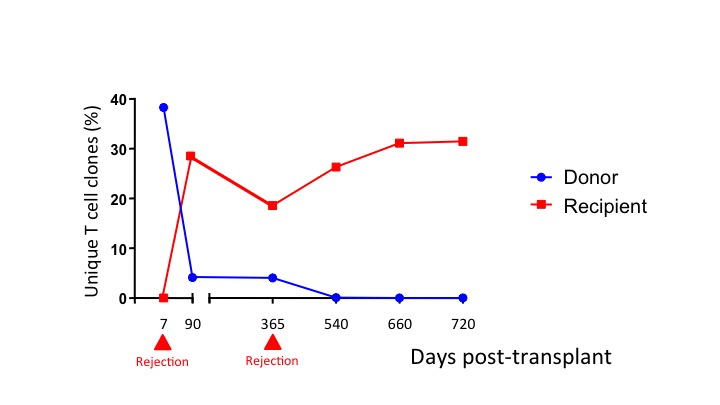Contribution of Donor versus Recipient T Cells in Face Transplant Rejection.
1Brigham and Women's Hospital, Boston
2Broad Institute of MIT and Harvard, Cambridge
Meeting: 2017 American Transplant Congress
Abstract number: B294
Keywords: Rejection, T cell clones, T cell receptors (TcR), T cells
Session Information
Session Time: 6:00pm-7:00pm
 Presentation Time: 6:00pm-7:00pm
Presentation Time: 6:00pm-7:00pm
Location: Hall D1
Background
Skin-containing transplants such as facial allografts contain resident populations of donor T cells. Although the role of T cells in acute rejection is well established, the relative contribution of donor versus recipient T cells in rejection is unexamined.
Methods
High throughput T-cell receptor sequencing was used to track donor T cells following clinical face transplantation. For each donor-recipient pair (n=3), we first established the fingerprints of both donor and recipient T cell repertoires before transplant, and tracked those clones in allograft and blood after transplant during rejection and non-rejection, up to 4 years following transplant.
Results
Donor T cell clones predominated early within facial allografts, persisted for up to 1 year post-transplant and disappeared over time. Donor T cells showed clonal expansion during rejection, suggesting that they may participate in rejection. In contrast, the frequency of recipient T cell clones in the allograft increased progressively and dominated at later rejection episodes. Importantly, analysis of paired allograft biopsy and blood samples collected at the same timepoints demonstrated that pathogenic T cell clones that expanded in the rejecting allograft also showed clonal expansion in peripheral blood, and that their frequencies, both in allograft and blood, decreased after the rejection resolved.
Conclusions
Our study suggests that donor T cells persist within allograft after transplant and contribute to early episodes of rejection. Recipient T cells migrate into the allograft during rejection and over time become predominant. Clonally expanded T cells infiltrating the rejecting allograft can be detected in peripheral blood, raising the possibility the frequency of patient-specific pathogenic T cell clones in blood may serve as a non-invasive and personalized rejection biomarker for rejection.
CITATION INFORMATION: Win T, Murakami N, Avraham-Davidi I, Teague J, Lowry E, Lopdrup R, Bueno E, Chandraker A, Riella L, Pomahac B, Clark R. Contribution of Donor versus Recipient T Cells in Face Transplant Rejection. Am J Transplant. 2017;17 (suppl 3).
To cite this abstract in AMA style:
Win T, Murakami N, Avraham-Davidi I, Teague J, Lowry E, Lopdrup R, Bueno E, Chandraker A, Riella L, Pomahac B, Clark R. Contribution of Donor versus Recipient T Cells in Face Transplant Rejection. [abstract]. Am J Transplant. 2017; 17 (suppl 3). https://atcmeetingabstracts.com/abstract/contribution-of-donor-versus-recipient-t-cells-in-face-transplant-rejection/. Accessed December 17, 2025.« Back to 2017 American Transplant Congress
